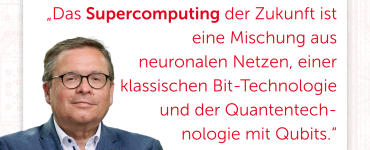Matthias Reidans, Senior Project Manager Service at Rosenberger-OSI and an expert in quantum innovation, discusses the transformative power of quantum technology. In this interview, he highlights which industries are already developing initial use cases, which infrastructural requirements companies need to create, and how the journey “from lab to fab” can succeed.
Mr Reidans – Quantum technology is today…
…one of our most important investments to address the future global challenges in society, business and technology with a wealth of opportunities!
What should companies already know and take into account today with regard to their products and services in an increasingly quantum-based future?
Every new technology brings both opportunities and risks – this also applies to the five key areas of quantum technology. Companies should deeply explore the potential opportunities and risks involved. Some industries, such as finance, are already working on initial use cases and developing specific use cases. Other sectors, such as materials science, place high hopes on new product qualities, which is leading to future-oriented investments and skill development.
In which industries do you expect quantum computing to have the greatest impact on business processes? How can companies prepare for this strategically?
The IT security industry, as well as research institutes and companies in the field of artificial intelligence, will probably be among the first key players in this quantum revolution. Banks, the chemical industry and the telecommunications sector will also undergo major changes as a result of quantum computing. Quantum sensing will also have a significant impact on robotics, logistics and the quality of simulations. However, many of the changes to existing processes are still difficult to predict.
In your opinion, what technical requirements and infrastructures do companies need to create in order to effectively participate in quantum technologies?
In the field of quantum computing, there are currently various approaches: stationary systems that are operated on-premises and connected via the cloud, as well as mobile units that are being developed for different purposes. Companies aiming to leverage the innovation potential of quantum technology must first align their infrastructure and resources accordingly. Cost-effectiveness, operational security and reliability are crucial criteria for realistic use cases.
What role do new hardware requirements and cloud-based quantum solutions play in this?
Since it is currently still unclear which quantum computer architectures will be reliably and quickly deployable – for example, those with functional error correction beyond the “NISQ era” (Noisy Intermediate-Scale Quantum) – the path forward is not yet fully mapped out. Scalable systems need to be reproducible and affordable. Cloud-based quantum solutions already exist, including in Germany. Currently, the cost of using Quantum Processing Units (QPUs) ranges from 1500 to 5000 euros per hour.
How can companies ensure that their existing IT and data processing structures are prepared for the integration of quantum computing? What technical adjustments or modernisations are required?
Integration requirements and initial standards are currently being defined, for example by the new DIN SPEC 91480:2024-11. However, important technical developments, such as the BB84 protocol for quantum-safe communication, are still in the early stages of widespread implementation. Questions remain about the redundancy of new systems and the expansion of intercontinental connections. The journey from the lab to the fab – from prototype development to industrial production – has just begun. However, the prospect of tap-proof communication is a significant driving force for progress.
Thank you very much, Mr Reidans!




